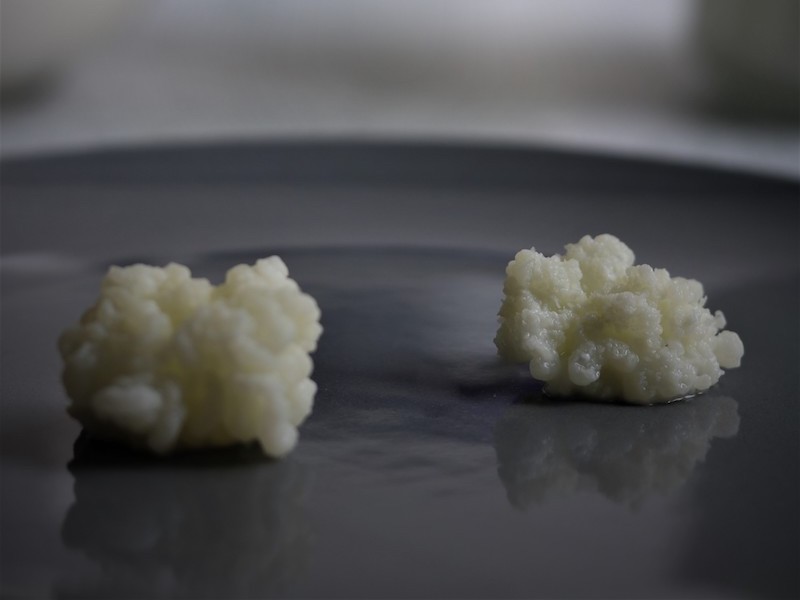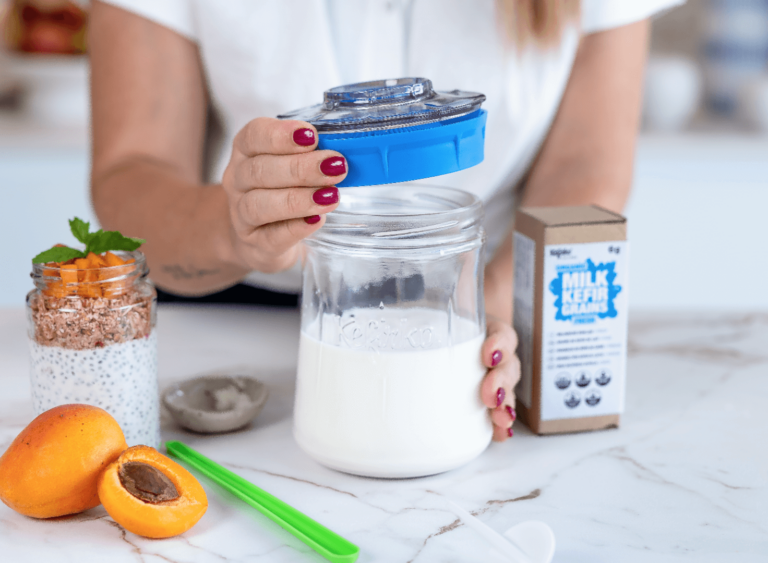5 tips that can help grow kefir grains

Looking for ways to help grow kefir grains?
If you are not satisfied with the way your kefir grains are multiplying, here are the tips on how you can change that. Even though the most important thing is that the taste and smell of kefir is satisfactory, sometimes this goes hand in hand with their growth.
Read on for advice on how to stimulate your kefir grains.
1. tip: Adjust the temperature
Sometimes the grains are not growing because the temperature in the room is too low. Lower temperatures are slowing down the fermentation and the growth of grains. It’s best to leave the grains in optimal temperature and not changing it all the time, that puts stress on the grains and they will not grow.
Maybe you noticed kefir ferments faster in warmer season, this also affects the growth of the grains. The fermentation is faster in this case and you should mind the over fermentation which also isn’t great if it happens too often.
Optimal temperature for the kefir grains is 22 – 25 °C.
2. tip: Feed the grains enough food
The kefir grains need food for fermentation. The ratio between the grains and feed is also of importance. In milk kefir, the feed is lactose in the milk. To prepare water kefir you have to add sugar which feeds the grains.

Ratio grains : sugar-water/milk is important
If you use too much milk for milk kefir, the grains will need more time to ferment. In this case the milk can go off before the grains can ferment it.
When using too much grains for the amount of milk, milk kefir grains will not have enough food and they will starve. In this case over fermentation starts which can, if done often, damage the grains.
Lack of feed can be remedied by adding powdered milk to the kefir which has lots of lactose – the sugar in milk which acts as food for grains.
You can add minerals to the kefir: mineral drops, rapadura sugar, raisins, figs, etc. Or try adding some powder milk to increase lactose amount in milk.
You should prepare water kefir with fresh, non-chlorinated and non-filtered water. The chlorine in the water can kill the bacteria strains in the grains, while filtered water lacks the minerals that kefir grains feed on. It’s ideal to use natural spring water full of minerals to encourage the growth of grains.
Water kefir ratio:
Recommended ratio is 1 tbsp sugar : 1 tbsp kefir grains : 1 cup water
Milk kefir ratio:
Recommended ratio is 1 part grains : 10 parts milk.
3. tip: Separate bigger grains
Smaller grains grow faster because they have bigger areas in contact with their feed. If you have very big grains consider separating them into smaller ones. Be gentle when doing this so you don’t damage them.

4. tip: Take less breaks
Kefir grains work best when they are active all the time. Continuity is the key if you want to make a delicious homemade kefir. It’s ok if you take a break from kefir from time to time, just make sure these breaks aren’t to often. This break is usually quite stressful for the grains. To slow their activity we usually put them in a cold place. To keep the grains healthiest avoid doing this too frequently. It may be hard for them to become active again.
5. tip: Shake and stir
 Shake/stir the grains during fermentation so you can encourage more milk gets in contact with the grains. The contact area between grains and their food is where the magic happens. Bigger it is, faster the growth of the grains will be.
Shake/stir the grains during fermentation so you can encourage more milk gets in contact with the grains. The contact area between grains and their food is where the magic happens. Bigger it is, faster the growth of the grains will be.
Those of you who are have many experience with making kefir at home may have some other tips on how to help grow kefir grains. Please share them in the comments!
You can get milk and water kefir grains here:








I’m going to try adding a little non-fat dry milk to my kefir; its carbohydrate count is 100% sugar (lactose).
We recommend using full fat fresh organic milk to enable enough food for grains to grow.
” but avoid over-pasteurized milks.”
In my humble research, I found ALL commercial organic milks to be “Ultra Pasteurized”
which I found it be defined as higher temps at longer duration
Can anyone respond to this enigma ?
Hi there! Thanks for opening this debate.
Have you tried with fresh milk? You can buy it in stores too. Some of them are “heated” only to a certain lower temperature for a short time, they are still considered fresh milks and are stored in the fridge.
I’ve found the same. That’s all my grains have ever known and they’re healthy and multiply enough for me to share 1 Tb every other month
I have found a couple organic milks that are not UHT Pasturised. It is $8 a gallon and hard to find, but that gives me the best results. Having worked a few summers on an organic dairy farm, I would rather pay a little extra for the better quality. After all; we are what our food eats.
I buy Natural by Nature in NJ – it’s not ultra-pasturized.
I think they mean UHT milk
How about freezing kefir grains? There are times when we have enough kefir for our purposes, and don’t want to keep making more …
Thanks!
I also would like to know the answer to your question. I am the only consumer of milk kefir in my home and often have more than I can use in a day or two. Keep my grains in the fridge.
Kind regards
How can I get enough grains, to make Cheese with them, please?
Hi, today I bought kefir grains online but it is not visible and i asked about this to the Seller. He says to do 7 fermentation’s so that grains will grow. My question is will it grow within 7 fermentation’s or he is lying.
Hi there,
I can’t find you in our database, did you buy through our website?
We sell live reusable cultures, that’s small granules. I’m not sure what you mean by that they are not visible?
It takes a bit to activate kefir grains after receiving them. It can take a week or so, but even from the start you should have the grains to begin with.
I have just bought my first milk kefir grains 5g and added 250ml organic full cream milk. My question is after the first 24 hrs when I strain the kefir do I just continue to add 250ml more milk every day to the grains, how much milk should I add when the grains multiply?
Hi Amanda,
you can use less than 250ml when activating the grains. You need to change the grains until the smell, consistency and taste of kefir is ok. You can wash the grains with lukewarm water first few days.
When they are activated, you can use more milk (600ml). After the grains multiply, you can add more milk or take away some grains. It depends on the taste of kefir you want to have and the consistency. You can have lots more grains for that amount of milk.
All the best! Kefirko team
How much Milk should I use, if I have about half to 1 teaspoon of grains, please?
I make 2 cups with 1 tsp.
From Kefirko’s directions, above:
Milk kefir ratio:
Recommended ratio is 1 part grains : 10 parts milk.
so 1 tsp grains (5ml) would make only 50 ml, not even a quarter of a cup, of kefir?
Hi Katherine, depending on the ratio of kefir. We recommend 1:100.
Regards, Kefirko team
The consistency now looks like thickish curdled milk, have tried putting out overnight as it is hot in Brisbane at the moment during the day. When strained it just looks lumpy not like little cauliflowers.
Smells ok, have tried adding more milk and less milk just seems to be thickish consistency.
1) How do I know, when the Smell and Consistency is right to use?
2) Can I use the Liquid, for anything other than, just to drink?
3) How much should I drink of Kafir, per day?
Thank you.
I have had this batch of kefir grains for about 8 months. About 2 months ago, I took a long break from them ( 1 week in the fridge). The kefir has not tasted or smell like it did since then. The tartness is overpowering. I still drink it, but wondered if it’s safe. The grains are also not growing much at all. I use full fat milk and change them every 24 hours. I also only use plastic to clean them. Any suggestions? Should I just get new ones? How would I know they are dead or permanently damaged?
Hi there,
thank you for your question. The changes like these can affect the grains in some way. Usually takes some time, even months in some cases to get them to the way they were. It’s important to stay consistent and feed the grains regularly. Note, if you don’t trust the kefir is OK to consume, if the smell and taste are way off, it’s better to discard the batch and get new cultures.
All the best from Kefirko team
Hi I bought some coconut kefir grains from your site about a month ago but the grains don’t seem to be growing. In fact they seem to be shrinking in size. I use organic coconut cream and a little organic almond milk. I change after about four days. I have put a table spoon of organic raw sugar in with them because I thought I might be starving them.. I’ve had mill kefir grains before and couldn’t stop them growing. Any tips on how to get the coconut milk legit growing would be great.
Thank you in advance
Hi Mark!
Thanks for contacting us. We do not sell coconut kefir grains, only regular milk kefir grains. Check the packaging for the ones you bought to see who was the producer of your item. All the best, Kefirko team
I have found a couple organic milks that are not UHT Pasturised. It is $8 a gallon and hard to find, but that gives me the best results. Having worked a few summers on an organic dairy farm, I would rather pay a little extra for the better quality. After all; we are what our food eats.